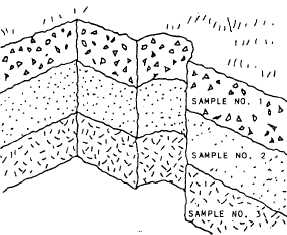Table 15-2 shows methods of underground
exploration and sampling in a condensed
form.
TAGGING SAMPLES
Let us suppose that soil in a given area
is to be tested (such as the area on which
a structure is to be erected). The officer
in charge of soil exploration decides how
many points are needed and where they must
be located to produce a representative test
of the soil in the area. This information is
recorded in a sketch like the one shown in
figure 15-3.
This figure shows the locations of ex-
ploratory points along a highway, the point
locations referenced by the center-line station
and the distance from the center line. To
the left of the center line, between stations
2 + 80 and 4 + 60, there is a borrow pit,
from which soil for fill is taken. The soil
here is tested by samples taken from a 60-ft
trench (T1), located at station 3 + 20, 300
ft from the highway center line; from two
borings (B1 and B2) at stations 3 + 60 and
3 + 80, 230 ft and 420 ft from the center
line, respectively; and from a 20-ft- square pit (P2)
at station 4 + 20, 300 ft from the center
line.
Besides the borrow pit exploration, there is a
boring (B3) at station 4 + 80, 125 ft to the right
of the center line; another boring (B4) at station
6 + 00, 100 ft to the left of the center line; and
a 20-ft-square pit (P3) on the center line at sta-
tion 7 + 20.
Each sample taken is tagged according to
the location from which it was taken. Loca-
tions are given in consecutive numbers; for
those shown in figure 15-3, the numbers might
run from the bottom up, with T1 being No. 1;
B 1, No. 2; and so on. A sample is tagged with
the project symbol (the symbol for the project
shown in fig. 15-3 is BF) and the location sym-
bol (such as T1 or B1). If more than one sample
is taken from the same location, you need to use
additional numbers. For example, a sample taken
from B2 in figure 15-3 maybe tagged ‘‘BF-B2-4,
bag 1 of 6.” This means
tion No. 4, the first of 6
location.”
“boring No. 2, loca-
bags taken from that
The sample identification is printed with
a marking pencil or pen on two tags, one of
which is placed inside the bag, and the other of
which is tied on the outside. Gummed labels
may be similarly used to identify samples that
are placed in moisture content boxes, cylinders,
or jars.
DISTURBED SAMPLES
Samples taken by hand scoops, auger bor-
ings, shovels, or any other convenient hand
tool with no attempt to obtain the material
in its natural state of structure or density is
known as a DISTURBED sample. These samples
are used for mechanical analysis, plasticity,
specific gravity, frost susceptibility, compaction,
and laboratory compacted CBR tests. The size of
the sample taken will depend upon the tests to be
performed.
Individual Samples
When taking individual samples from a
pit, trench, or exposed face (fig. 15-4), first
shave off loose and dried soil to obtain
a fresh surface and to expose any soil varia-
tions clearly. Then take a typical sample of
each type of soil or of those requiring ad-
ditional investigation. When sampling in auger
holes, place typical portions of the soil obtained
Figure 15-4.-Obtaining individual bag samples from an
exposed face.
15-9


